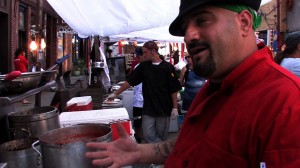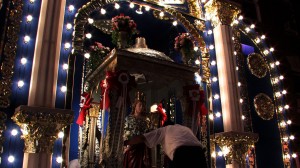‘Viva! Saint Agrippina’ unveils the Italian traditions of Boston’s North End

Every culture has its traditions, but few could match the exuberance of the Italian-American community in Boston’s North End. In this vibrant neighborhood, where the local Catholics pledge their devotion to Saint Agrippina of Mineo, Sicily, the men of the community hoist a statue of their patron saint onto their shoulders for a three-day festival that features singing, dancing, necklaces of dollar bills and even some fried calamari.
The new documentary, Viva! Saint Agrippina, looks into the arduous preparation for the festival and the varied events that take place on the celebratory first weekend of August. Everything is centered around this beautiful statue of a lady holding the cross. On Friday, when the celebration begins, her head is veiled with red fabric until a member of the Saint Agrippina Benefit Society ceremoniously removes the garment and the festival kicks into high gear.
Over the course of three days, the statue is brought through the streets in an ongoing parade. To see the spectacle through the lens of director Christopher Di Nunzio is a special treat. Here’s a community in love with a woman who lived more than 1,700 years ago — if that’s not faith, I’m not sure what is.

The festival has become as much a cultural tradition as a religious ritual. Only Italians are allowed to join the society that hosts the celebration, but the streets of Boston’s North End are filled with diverse communities coming together to enjoy food and family.
The documentary, which runs 91 minutes, is basic and lacking in pretentiousness. Its production value is minimal, and many of the shots are shaky and slightly confused. Still, Di Nunzio captures the spirit in the air and knows how much the subject matter means to the people on the other end of his interview questions. In fact, it’s somewhat refreshing to see so many grown men open up about their feelings of Saint Agrippina. These are not quiet, personal people wishing to remain out of the spotlight. They have been influenced by their dedication to the patroness and truly want the world to know about their love. It’s also nice to see the connection between fathers and sons.
The society is fairly strict with its membership rules. The volunteers chosen to hold up the enormous statue of Agrippina are part of a privileged few. One can either inherit a coveted spot (from father to son), or they need to bid on a spot at an annual meeting. The exclusiveness of the organization has less to do with setting these men apart from the community, and more to do with upholding a tradition that dates back almost 100 years. These volunteers are not merely part of a social club; they fully believe in their “family princess,” and can recite her history from memory.
A few important topics are missing from the documentary. Throughout the three-day festival, the statue is showered with money from spectators. It’s never clear where this money goes and what’s the reasoning behind the ritual. The funds likely help the society in its outreach efforts and humanitarian work, but no explanation is offered.
Also, except for a brief opening prayer from a local priest, much of the religiosity behind the festival is missing. There’s more focus on the food and cultural traditions (including a tug-of-war with the statue), while any talks of how Saint Agrippina fits into the greater idea of the Christian faith are absent.
Still, it’s hard not to fall in love with the film. There is so much positivity and family love in these 91 minutes that the ebullient feelings prove to be infectious. One particular interviewee talks passionately about how the society has welcomed him into its folds, and that he has a great feeling of devotion and thankfulness to the saint. His sentiments almost bring him to tears.
Di Nunzio’s documentary achieves its loftiest goal: After watching Viva! Saint Agrippina, one wants to know more about the “family princess” and definitely plan a trip to Boston’s North End on the first weekend of August.
I dare you not to scream “Viva!” along with these enthusiastic devotees.
By John Soltes / Publisher / John@HollywoodSoapbox.com
-
Viva! Saint Agrippina
-
2010
-
Written and directed by Christopher Di Nunzio
-
Running time: 91 minutes
-
Rating:





